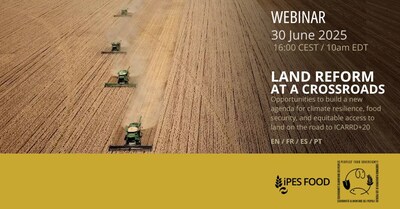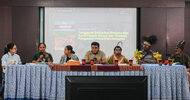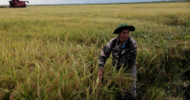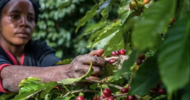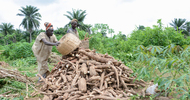By: Baba Sillah
The development of the global food economy/regime/system has transformed peasants’ livelihoods, politics, and ways of resistance. To answer the 21st century agrarian question, it is important for researchers and activists alike to understand not only local politics and capitalist relations in which peasants are placed but also peasants’ position in the global economy. This article discusses the various ways in which scholars and activists of the global food economy/regime/system examine the relationships among producers, the state and capital. Additionally, the trajectory of the global food economy/regime/system and the functions and relations of smallholders, the state, capitalists, and international organizations are discussed.
Keywords: Food economy, agriculture, land, peasants, capital.
1. Introduction
Scholars and activists of the global food regime have examined the relations among producers, the state and capital through the lenses of unequal power relations among actors in the global food regime spaces. Actors in the global food economy including producers, the state and corporate capital and international organizations like the World Trade Organization (WTO) represent different and unequal proportions of power and influence in the global system and within the realm of international political economy. Therefore, by examining these actors through the lenses of unequal power relations, scholars derive deeper appreciation of the political, economic and social conditions that characterize not just the context in which the actors operate but also the disparities in the degree of power they bear and the reproductions of disparities that is the outcome of the dispensing of their different degrees of power.
2. Relations between producers, the state and capital
In their examination of the global food regime, some scholars have focused their analyses on themes ranging from land inequality and mechanization between peasant farmers and highly-capitalized industrial farmers (Borras et al 2009; Scott 1985). Others have emphasized disparities in access to agricultural inputs (e.g. fertilizers, seeds, pesticides, insecticides), and others have seen it befitting to shine the critical spotlight on global commodities chains and chains-of-chains, including the standardizations and control practices of such international organizations like the World Trade Organization (WTO) (McMichael 2016). Highly financialized producers are not only farming food crops, they are also farming animals such as broiler and layer chickens and cattle for beef. Apart from the health and environmental ramifications of the chemically accelerated processes of production, animal farming requires massive swathes of land for grazing and the production of animal feed (Weis 2007). Through the lenses of power relations, the trajectory of the global food economy, and the functions and relations among the actors therein are crystallized.
3. The political-economy perspective
Relations between producers: Contemporary agricultural food production, is experiencing productivity levels like at no other time in human history (FAO 2002a). However, high levels of productivity are confined to only a few firms with the capital to undertake large scale processes (Weis 2007). Large scale productive processes require massive investments in land, machinery, labor and inputs. Unfortunately, the current global food regime is so structured that only a few producers, whose operations have transcended national borders have the capacity (particularly capitalization) to invest in the factors of production. While high industrial agricultural production levels may generally appear as a positive advancement for humanity, such a perspective can be rather misleading. The massive production of food has not provided a definitive solution to hunger and food insecurity (Araghi 2000). The hunger problem has only moved from “hunger amidst scarcity” to “hunger amidst abundance” (Ibid. p. 155). Scholars are now concerned with the effects that mono-cropping is having on decline in the diversity of crop species and genetic diversity within particular species, and the limited choices that consumers now have when they shop because of conditions which result largely from mono-cropping (FAO 1997b). Through branding and flavoring (Schlosser 2002), large scale food producers have essentially almost erased the cultural, seasonal and local significance of food through appropriating local foods and creating “commercial pseudo-variety” (George 1990, p.44), placing them on supermarket shelves as processed and pre-prepared foods. Relationships between large agro-TNCs and small producers have been based on struggles over market shares, land sizes, access to water, and the degradation to the ecosystems from pollution caused by the use of pesticides and huge quantities of synthetic fertilizers that affect the environment adversely. In the age of agrarian capitalism, this relationship narrows down to a dominance of capital, the domain of big producers over smallscale agricultural producers. Said dominance comes in many forms including low wages for workers, low prices for crops for small producers and control of regional and global commodity chains (McMichael 2016, Weis 2007).
The state: Scholars and activists view the state no longer as an inactive bystander or a simple mediator in agrarian affairs. The state has increasingly become an active agent in stimulating agrarian change and in making political decisions that have planned and unplanned ramifications for the lives, livelihoods and mode of behavior of small-scale/peasant subsistence farmers and industrial farmers too (Rahmato 1983; Scott 1998; Weis 1997; Scott 1985). Therefore, scholars of the global food system also analyze state agrarian policies with keen emphasis on locating the center of the concentration of policy. They tend to be attentive to whether state policy is meant to protect and empower small farmers through specifically designed interventions (e.g. Subsidies, agro-inputs, land distribution, agricultural financing) or protecting industrial farms through emphasis on free trade in agricultural goods that tend to undermine local peasant farmers due to uneven competition. Although often varied in the foci of their scholarly examinations, scholars have tended to converge on the fundamental idea that the relationship between producers has been uneven (Weis, 2007). Political analyses of the relations between producers, the state and capital are especially crucial because even though the state is the major unit of analysis in international relations, over the years, multinational corporations such as agro-TNCs have become extremely wealthy based on their control of the global food economy, they have been able to significantly influence the decisions of state. Some of the debates have been about the agricultural subsidies provided by developed countries’ governments to their food producers which empower them to mass produce and how they exploit the liberalized or free trade environment provided under the Washington Consensus to flood the markets of non-competitive producers in developing countries. This debate points to how the domestic production of local producers is undermined by cheap external food products. A prime example of this can be traced back to the 1950s U.S. government Public Law 480 (PL480) through which the US intervened in its domestic agricultural sector by providing subsidies to cover inputs and agricultural machinery. This effort led to excess food production which in turn led to a downturn in food prices in the US ultimately reducing the profitability of agriculture. In response, the US government decided to export as food aid to friendly and allied countries this agriculture food surplus. This gesture was welcomed by politicians in so-called Third World/developing countries who wanted to please their urban population bases and secure their political stability. An obvious “urban bias” that disadvantaged local food producers who could not compete with the cheap imports because they did not have the same levels of inputs (Weis 2007). Nonetheless, in the Global South where agriculture was used by the state as a tool in its import substitution strategies to achieve accelerated industrialization, more inequality resulted between farmers and exacerbated rural poverty (Bates 1981; Schiff and Valdes 1992).
Given that big producers have access to financial and other forms of capital which due to limited state retainers of finances are mobile and considering that the state is always on the hunt for foreign capital as Foreign Direct Investment, there tends to be very close cooperation between state and big food agribusinesses. Scholars and activists of the global food economy believe that to control the excesses of big producers and protect small farmers from the risk of being totally incorporated into and exposed to the vagaries of the market, the state has to institute tough and fair policies. Policies that not only guarantee the provision of agricultural inputs and financing for small producers but also ensure certain degree of protectionism against big producers from developed countries and guarantee larger shares of domestic markets for small-producers.
International Organizations: Much of the problems with the small peasant producers, agro-TNCs and the state is believed to be caused by the interventions of international organizations such as the World Bank (WB) and the WTO (Desmarias 2002). Trade liberalization has removed protections for domestic industries including small food producers leading to their domination by multinational firms. Also, financial liberalization has made it possible for capital to be moved with ease from one location to another as corporations see fit. International Governmental Organizations like the WTO tend to be dominated by big and powerful countries that put the interests of their domestic businesses first giving them unfair advantages. Demands for substantive reforms have largely gone unheeded resulting into anti-globalization demonstration such as the ones in Seattle, Washington in 1999 and Cancun (Weis 2007; Das 2003). Some peasant organizations have even argued that agriculture and food should be completely removed from the purview of the WTO (Desmarais 2002:105). International organizations like the TWO and WB are responsible for the institutionalization of the unequal power relations in the global economy and continue to pay mainly lip service to efforts and calls for reforms.
4. Conclusion
Finally, the current trajectory of the global food economy is dominated by profit making motives and is headed in a negative direction. Small-holder farmers are exposed to reducing crops (farm gate) prices and continue to operate under conditions of land inequality, low productivity, lack of access to financing, and threats from rapid urbanization. Their livelihood operations, farming methods, rudimentary tool and particular interest in protecting their land have been systematically characterized by the state and some international bodies as primitive and backwards (Geertz 1963). Such characterizations packed with undignified inflections, although a misrepresentation of the peasantry, have unfortunately worked in the favor of both the state and capital that have consistently sought to encroach on their land in the name of modernization (Ibid). Even so, it is vital to continue to stress that smallholder farmers are not primitive, and that they do still make up about two-fifths of humanity (Draghi 2000; Bernstein 2000). Moreover, instead of the current fossil fuels induced agricultural productivity, there is a safer, more sustainable and resilient way to grow food by applying agroforesty techniques and agroecological based principles to farming. These farming methods which are steeped in agrobiodivesity and environmental sound are best understood by smallholder peasant farmers (Carney 2021).
References
Araghi, F. 2000. ‘The great global enclosure of our times: peasants and the agrarian question at the endo of the twentieth century’, in F. Magdoff, J.B. Foster and F.H. Buttel (eds), Hungry for Profit: The Agribusiness Threat to Farmers, Food, and the Environment, New York: Monthly Review Press, pp. 145-60.
Bates, Robert E. (1981). Markets and states of tropical Africa. Berkeley: University of California Press.
Bernsten, H. (2000). ‘“The peasantry” in global capitalism: who, where and why?’, in L. Panitch and C. Leys (eds), Socialist Register 2001: Working Classes, Global Realities, New York: Monthly Review Press, pp. 25-51.
Borras, S.M. Jr., M. Edeleman and C. Kay, eds. 2008. Transnational agrarian movements confronting globalisation. Special issue of Journal of Agrarian Change, 8(2–3).
Carney, J.A. (2021). Subsistence in the Plantationocene: dooryard gardens, agrobiodiversity, and the subaltern economies of slavery, The Journal of Peasanrt Studies, 48:5 1075-1099, DOI:
Das, B.L. (2003). ‘Salvaging WTO from Cancun Collapse’, Third World Network, 20 September www.twnside.org.sg/titletwininfo78.htm
Desmarais, A.-A. 2002. The Vı ́a Campesina: consolidating an international peasant and farm movement. The Journal of Peasant Studies, 29(2), 91–124.
FAO (2000a). World agriculture: Towards 2015/2030-Summary Report, Rome: FAO
------------ (1997b). The state of the world’s plant genetic resources for food and agriculture, Rome: FAO
George, S. (1990). Ill Fares the Land: Essay on Food, Hunger and Power. London, Penguin
Geertz, C. 1963. Agricultural involution: the process of ecological change in Indonesia. Berkley, CA: The Association of Asian Studies, University of California Press.
Rahmato, D. (1983). Agrarian Change & Agrarian Crisis: State Peasantry in Post-Revolution Ethiopia, Africa; Journal of International African Institute, vol.63 No.1, Cambridge University Press
Schlosser, E. (2002). Fast Food Nation: The Dark Side of the All-American Meal, New York, Perennial
Schiff, Maurice and Valdes, Alberto (1992). The political economy of agricultural pricing policy, a synthesis of the economics in developing countries, Vol. 4. Baltimore: Johns Hopkins Press, for the World Bank.
Scott, J.C. 1985. Weapons of the weak. Everyday forms of peasant resistance. New Haven, CT: Yale University Press.
-----------(1998). Seeing like state: How certain schemes to improve the human condition have failed. new haven: Yale press:
Weis, T. 2007. The Global Food Economy: The Battle for the Future of Farming. London, Zed Book.


